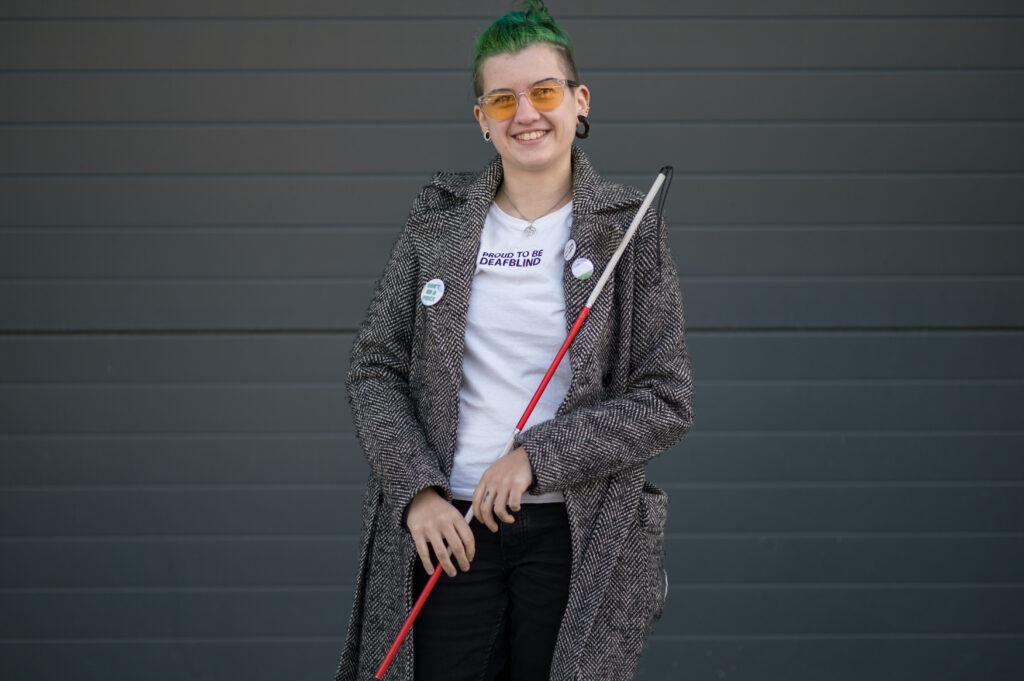Mobility canes
People with visual impairments use a variety of different types of cane to support them to move around.

On this page, find out more about the difference between a guide cane and a symbol cane, how to get a cane, and more.
On this page:
- Guide canes
- Symbol canes
- Long canes
- Red and white canes
- Do I need to use a cane?
- How to get a cane
- How to use a cane
Guide canes
Guide canes are used by blind and visually impaired people to help them move around. A guide cane is a long white stick that usually comes up to about the user’s waist.
You use it by sweeping or tapping the cane from side to side to get more information about what’s in your environment.
You can also hold it diagonally across your body to detect obstacles that are higher up.
By moving the cane around in front of you, you can feel any obstacles that are in your path. This could include kerbs, steps or any objects in your way.
Symbol canes
Symbol canes are canes that you hold in front of you to show people around you that you are visually impaired.
Unlike guide canes, you don’t actually use them to help you move or navigate your way around. Instead, they’re helpful for letting people around you know that you have low vision – especially in crowded places.
Symbol canes are usually shorter than guide canes. Some can even be folded up and put away inside your bag.
Long canes
A long cane is a longer version of a guide cane. It usually comes up to the user’s chest or armpit.
It allows you to feel obstacles that are further away in front of you.
Unlike a guide cane, a long cane usually has a tip that either rolls or points.
You usually need to have some training in order to be able to use a long cane effectively.
Red and white canes
Most people with visual impairments will use a white cane, but some people have red stripes on theirs.
This shows that they have a hearing impairment as well as sight impairment.
People who are deafblind may use any of the above types of cane (guide canes, symbol canes or long canes) with red stripes.

Do I need to use a cane?
Whether or not you want to use a cane to help you get around is up to you. Everyone’s situation is different.
If you’re partially sighted, you might find it helpful to carry a symbol cane to let people around you know that you can’t see very well.
If you have a more severe sight impairment, you might find that a cane helps you to be more independent.
To find out if a cane is right for you, you could request a needs assessment from your local social services.
To find out more, find a service or organisation for visually impaired people near you using the RNIB’s Sightline Directory.
How to get a cane
You can buy a cane independently, or you can get one by having an assessment from your local social services.
If you want to buy one yourself, you can buy canes from the RNIB, or many online retailers such as Amazon.
But it’s recommended to get a cane from social services. This way, you should be able to get your cane for free, and you’ll get trained in how to use it, too.
How exactly the process works will depend on where you live.
To find out more, use the RNIB’s Sightline Directory.
How to use a cane
When you get a guide cane or long cane, you should also get offered training in how to use it.
Training is the best way to learn how to use your cane. It will make sure that you’re holding it correctly and safely. People supporting you may need some training on how to support you effectively with the cane, too.
But these are some general tips:
- You can find obstacles in your path by sweeping your cane from side to side.
- You can also hold the cane diagonally across your body to protect you from obstacles in front of you.
- Some people use their cane to follow along with kerbs or building lines. This helps them to navigate their route.
- You can also use your cane to feel tactile paving, which usually alerts you to an upcoming hazard (like a road crossing).
- Guide canes and long canes can also help you locate stairs. You can use the cane to tell when you’ve reached the top or bottom of the stairs, and whether they’re going up or down.
Get in touch
Get in touch for more information and advice about communication.
This content was last reviewed in September 2023. We’ll review it again in 2025.
